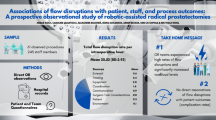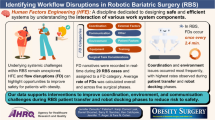Abstract
Introduction and hypothesis
The purpose of this study was to apply a human factors research approach to identify flow disruptions, deviations in the optimal course of care, in robotic abdominal sacrocolpopexy procedures with the ultimate goal of developing system interventions to improve the safety and efficiency of robotic surgery.
Methods
Twenty-four robotic abdominal sacrocolpopexy procedures were observed for flow disruptions. Surgeries were divided into four phases: (1) patient arrival and induction of anesthesia; (2) port placement and robot docking; (3) console time; (4) undocking of robot, incision closure, and patient exiting the OR.
Results
Flow disruptions were observed at a rate of 10.9 ± 5.1 per hour. The most frequently observed flow disruptions involved training issues (2.8 ± 2.4 flow disruptions per hour), equipment (2.2 ± 1.6 flow disruptions per hour), and poor coordination (2.0 ± 1.3 flow disruptions per hour). The rate of flow disruptions was highest in phase 2 (19.2 ± 14.4 flow disruptions per hour). Cases with more experienced surgeons involved shorter console times by 1.5 h (95% CI: 0.1, 3.0, p = 0.033) and 1.8 fewer (95% CI: 1.2, 2.6, p = 0.001) flow disruptions per hour. Surgeries were 1 h shorter on average (95% CI: 0.1, 1.9, p = 0.034) in cases in which the patient was > 65 years old. Da Vinci S console times were 0.8 h longer (95% CI: 0.01, 1.5, p = 0.047) than Si.
Conclusions
Flow disruptions in robotic abdominal sacrocolpopexy surgery occur about every 6 min. Flow disruption rates are highest during the most complex portions of the surgery. More experienced surgeons have lower flow disruption rates and operate more quickly.
Similar content being viewed by others
References
Wright JD, Ananth CV, Lewin SN, et al. Robotically assisted vs laparoscopic hysterectomy among women with benign gynecologic disease. JAMA. 2013;309:689.
Aarts JW, Nieboer TE, Johnson N, et al. Surgical approach to hysterectomy for benign gynaecological disease. Cochrane Database Syst Rev. 2015. https://doi.org/10.1002/14651858.CD003677.
Catchpole K, Perkins C, Bresee C, et al. Safety, efficiency and learning curves in robotic surgery: a human factors analysis. Surg Endosc. 2016;30:3749.
Catchpole K, Mishra A, Handa A, et al. Teamwork and error in the operating room: analysis of skills and roles. Ann Surg. 2008;247:699.
Nayyar R, Gupta NP. Critical appraisal of technical problems with robotic urological surgery. BJU Int. 2010;105:1710.
Wiegmann DA, Eggman AA, Elbardissi AW, et al. Improving cardiac surgical care: a work systems approach. Appl Ergon. 2010;41:701.
Catchpole K, Wiegmann D. Understanding safety and performance in the cardiac operating room: from ‘sharp end’ to ‘blunt end’. BMJ Qual Saf. 2012;21:807.
Carayon P, Schoofs Hundt A, Karsh BT, et al. Work system design for patient safety: the SEIPS model. Qual Saf Health Care. 2006;15(Suppl 1):i50.
Dru CJ, Anger JT, Souders CP, et al. Surgical flow disruptions during robotic-assisted radical prostatectomy. Can J Urol. 2017;24:8814.
Parker SEH, Laviana AA, Wadhera RK, et al. Development and evaluation of an observational tool for assessing surgical flow disruptions and their impact on surgical performance. World J Surg. 2010;34:353.
Catchpole KR, Giddings AE, de Leval MR, et al. Identification of systems failures in successful paediatric cardiac surgery. Ergonomics. 2006;49:567.
Catchpole KR, Giddings AE, Wilkinson M, et al. Improving patient safety by identifying latent failures in successful operations. Surgery. 2007;142:102.
McCulloch P, Mishra A, Handa A, et al. The effects of aviation-style non-technical skills training on technical performance and outcome in the operating theatre. Qual Saf Health Care. 2009;18:109.
Mishra A, Catchpole K, Dale T, et al. The influence of non-technical performance on technical outcome in laparoscopic cholecystectomy. Surg Endosc. 2008;22:68.
Catchpole K, Ley E, Wiegmann D, et al. A human factors subsystems approach to trauma care. JAMA Surg. 2014;149:962.
Funding
This study was funded by National Institute of Biomedical Imaging & Biomedical Engineering Award R03EB017447 (Catchpole/Anger) and the UCLA Medical Student Training in Aging Research Program—the National Institute on Aging (T35AG026736), the John A. Hartford Foundation, and the Lillian R. Gleitsman Foundation.
Author information
Authors and Affiliations
Ethics declarations
Conflicts of interest
None.
Additional information
Publisher’s note
Springer Nature remains neutral with regard to jurisdictional claims in published maps and institutional affiliations.
Institution at which work was performed: Cedars-Sinai Medical Center
Rights and permissions
About this article
Cite this article
Souders, C.P., Catchpole, K., Hannemann, A. et al. Flow disruptions in robotic-assisted abdominal sacrocolpopexy: does robotic surgery introduce unforeseen challenges for gynecologic surgeons?. Int Urogynecol J 30, 2177–2182 (2019). https://doi.org/10.1007/s00192-019-03929-6
Received:
Accepted:
Published:
Issue Date:
DOI: https://doi.org/10.1007/s00192-019-03929-6
Keywords
Profiles
- Ken Catchpole View author profile




